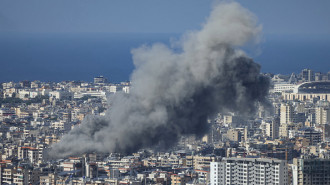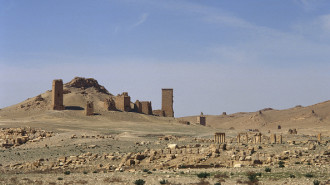Gaza heritage at threat as Israel bombs municipal buildings, old city
Israel’s widespread and intense six-week bombing campaign in Gaza has decimated the city’s municipal and historic buildings, as the temporary pause in fighting reveals the unprecedented ruin of civilian infrastructure.
Gaza’s City Hall building was shelled by Israeli forces, which resulted in the destruction of national archives, according to a statement by the Gaza Municipality shared on their social media pages.
Palestinian news agency WAFA said that two floors of the five-story central archive building had suffered damage, which destroyed important national documents and city records. Images shared by the municipality showed filing cabinets torn apart and burnt.
Since war broke out on October 7, Israel’s air and ground bombardment has decimated swathes of the enclave, with over 200,000 buildings destroyed or partially destroyed.
Despite Israel’s claims of only targeting Hamas infrastructure, major parts of civilian life in Gaza City have been wiped out, including universities, religious buildings, gardens, and schools.
Israel is "intentionally destroying" cultural and historical sites in Gaza, the Euro-Med Human Rights Monitor said on Monday.https://t.co/TdNxht34yM
— The New Arab (@The_NewArab) November 21, 2023
The municipality headquarters, located in the centre of the city in Palestine Square, stored historical archives dating back more than 150 years, which held key documentation of the city’s urban development, including mapping engineering studies of the water and sewage networks.
The municipality said that Israel had deliberately bombed the building and destroyed the documents "to plunge the city into chaos and destroy everything that symbolizes the city's history and civilization".
The targeting of civilian buildings also represented "a clear violation of international humanitarian law", the municipality said in a statement.
The pause in fighting between Hamas and Israel brought to the forefront the depth of destruction caused by Israel's relentless attack on the besieged enclave.
Earlier in the week, the municipality released photographs which showed Gaza City’s main public library in ruins. The municipality said the library had been regularly enjoyed by the city’s residents, including schoolchildren before the war began.
Another important cultural institution in the city, the Rashed Shawa Cultural Centre has also suffered severe damage. In 1998 the centre held a session of the Palestinian National Council between Palestinian President Yasser Arafat and US President Bill Clinton to discuss statehood.
Israel’s unprecedented six-week bombing campaign against Gaza has seen the destruction of aspects of civilian life particularly in northern Gaza. Universities, schools, public libraries and parks have been decimated.
Swathes of the tiny enclave have been flattened with 1.7 million of the just over 2 million population now displaced. Thousands of people are sheltering in makeshift camps and at schools and hospitals in the southern cities, dependent on handouts and with little access to clean water or sanitation.
Established Israeli tactic
The destruction of the municipality buildings is not the first time historical landmarks have been targeted by Israeli forces.
It is part of a longstanding Israeli campaign to erase Palestinian historic and cultural sites.
On the establishment of the state of Israel in 1948, Palestinian villages and towns were forcibly emptied and destroyed to make way for villages to house Jewish immigrants arriving in the newly created state.
Towns and villages were renamed as part of a total erasure of Palestinian indigenous culture.
Since the start of Israel's war on Gaza, Israeli authorities have seized the chance to carry out violations against Palestinians in the occupied West Bank.
On November 14, a monument to former Palestinian president Yasser Arafat which had stood at the edge of the Tulkarm refugee camp was bulldozed by the Israelis.
The Israeli forces provided no explanation as to why it was destroyed.
In October, the army destroyed a memorial in Jenin to Palestinian journalist Shireen Abu Akleh, where she was shot and killed by Israeli forces during a raid on the Jenin refugee camp in 2022.
🚨🚨🚨🚨🚨🚨
— TRAVIS | تراڤس (@irode0) November 14, 2023
طولكرم، الضفة الغربية ..
جيش الاحتلال يدمر تمثال تذكاري للرئيس الراحل ياسر عرفات
pic.twitter.com/fbbK0G7EfZ
What does international law say?
Under international humanitarian law, the destruction of cultural heritage can be considered a war crime. Cultural heritage is protected in international law by the 1954 Hague Convention for the Protection of Cultural Property in the Event of Armed Conflict.
The treaty obliges member states to safeguard property during conflict.
The International Criminal Court of Justice in the Hague says that: “Crimes against and affecting cultural heritage are a pervasive feature of the atrocities within the Court’s jurisdiction.”
Scholars and historians have argued that the targeting of cultural heritage serves as a deliberate attack on communities’ unique identities.




 Follow the Middle East's top stories in English at The New Arab on Google News
Follow the Middle East's top stories in English at The New Arab on Google News


![A group of Palestinians, foreign and Israeli activists gather to participated in an olive picking event on the land in the town of Battir, which is under threat of confiscation by Israel in Bethlehem, occupied West Bank on 8 November 2024. [Getty]](/sites/default/files/styles/image_330x185/public/2182930803.jpeg?h=199d8c1f&itok=__0LgGsa)